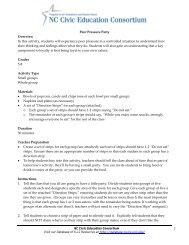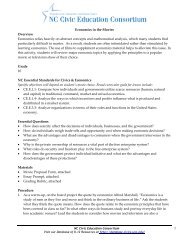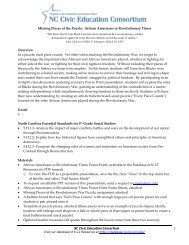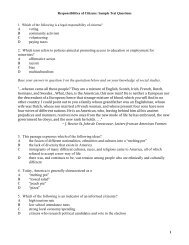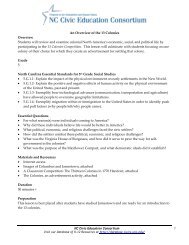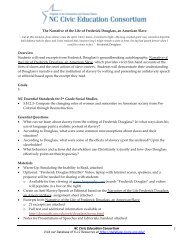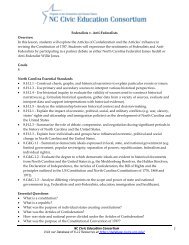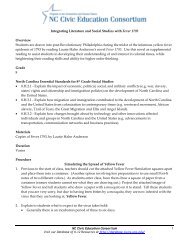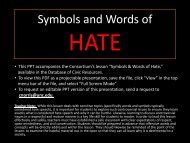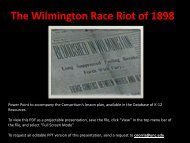American Abolitionists - Database of K-12 Resources
American Abolitionists - Database of K-12 Resources
American Abolitionists - Database of K-12 Resources
Create successful ePaper yourself
Turn your PDF publications into a flip-book with our unique Google optimized e-Paper software.
6. Project slide 8, which contains a poster advertising an “Anti‐Slavery Meeting” and continue<br />
discussing:<br />
• What is the purpose <strong>of</strong> this document and who do you think created it<br />
• What do you think prompted the creation <strong>of</strong> this document<br />
• How might the following people respond to this advertisement when coming across it<br />
(teachers can alternatively provide strips <strong>of</strong> paper to student volunteers with these choices<br />
written upon them; students can then respond when called upon by assuming the<br />
character/voice <strong>of</strong> the role assigned to them):<br />
o A freed Black<br />
o A slave owner<br />
o A housewife and mother <strong>of</strong> three<br />
o An escaped slave<br />
o A member <strong>of</strong> the Democratic Party<br />
o A Radical Republican<br />
o A Southern plantation owner<br />
o A minister<br />
• Note that in some <strong>of</strong> these cases, there is no right or wrong answer. For example, a<br />
student could argue that a minister would want to attend the meeting, claiming surely<br />
a religious person would not support such an inhumane institution <strong>of</strong> slavery. Yet,<br />
another student might note that a minister would be outraged by the meeting, since<br />
many people used religion as a way to defend slavery.<br />
• What do you think will be discussed at this meeting What types <strong>of</strong> decisions might be made<br />
7. Next, project slide 9 and review student answers to the questions posed at the end <strong>of</strong> their<br />
homework reading, “The <strong>American</strong> Abolitionist Movement,” discussing the following further:<br />
• Who were some leading abolitionists, either who were mentioned in the article or who you’ve<br />
learned about before What strategies did they use to resist slavery What facilitated and<br />
constrained their actions<br />
• It has been said that the pen is mightier than the sword. Do you think it was more effective for<br />
abolitionists to participate in armed rebellions, or to advocate through non‐violent means,<br />
such as through anti‐slavery writings Explain.<br />
• What was the constitutional and legal context that framed and legalized slavery<br />
o Review the various clauses in the Constitution that legalized slavery, as well as additional<br />
legal measures, such as<br />
• Article I, Section. 2 ‐ Slaves count as 3/5 persons<br />
• Article I, Section. 9, clause 1 ‐ No power to ban slavery until 1808<br />
• Article IV, Section, 2 ‐ Free states cannot protect slaves<br />
• Article V ‐ No Constitutional Amendment to Ban Slavery Until 1808<br />
• Gag rule instituted in 1836, tabling all petitions to end slavery<br />
• Fugitive Slave Act <strong>of</strong> 1850 – slaves were to be returned to masters<br />
• The Supreme Court, in its infamous decision in Dred Scott v Sandford (1857), ruled<br />
that Congress lacked the power to prohibit slavery in its territories and that slaves<br />
had no rights in the courts.<br />
• In many ways, abolitionists were <strong>of</strong>ten breaking the law by assisting runaways and/or<br />
advocating for emancipation. What risks were people taking by involving themselves in the<br />
abolitionist movement<br />
NC Civic Education Consortium 4<br />
Visit our <strong>Database</strong> <strong>of</strong> K-<strong>12</strong> <strong>Resources</strong> at http://database.civics.unc.edu/



